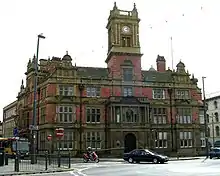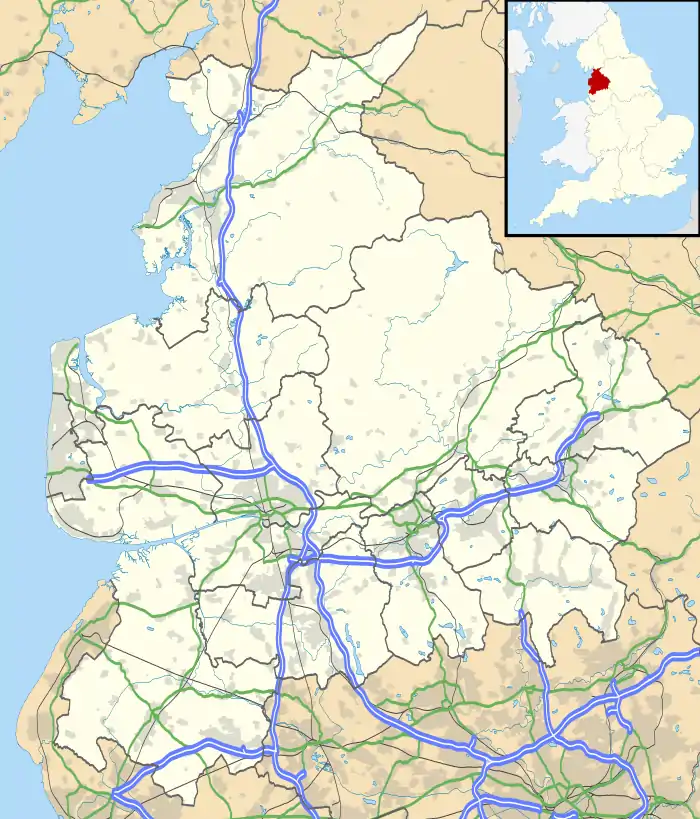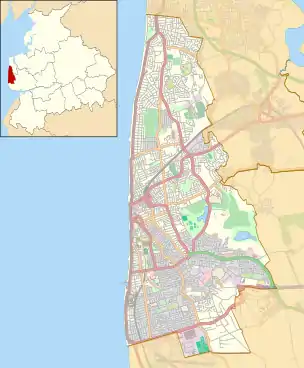Blackpool Town Hall
Blackpool Town Hall is a municipal building in Talbot Square, Blackpool, England. The town hall, which is the headquarters of Blackpool Council, is a Grade II listed building.[1]
| Blackpool Town Hall | |
|---|---|
 Blackpool Town Hall | |
| Location | Talbot Square, Blackpool |
| Coordinates | 53.8185°N 3.0546°W |
| Built | 1900 |
| Architect | Potts, Son and Hennings |
| Architectural style(s) | Jacobean style |
Listed Building – Grade II | |
| Designated | 11 January 1974 |
| Reference no. | 1205893 |
 Shown in Lancashire  Location in Blackpool | |
History
The building was commissioned to replace an 18th century town hall located just to the south of the current structure close to the old St John's Market.[2] The new building, which was designed by Potts, Son and Hennings in the Jacobean style, was built on Talbot Square and completed in 1900.[1] The ship's bell from HMS Foudroyant, which was wrecked on Blackpool Sands in 1897, was recovered and placed in the town hall, when it opened.[3] The murals in the council chamber, which were painted by J. R. Brown in 1901, portray, firstly, the marriage of King Henry VII (of Lancaster) to Princess Elizabeth (of York) in 1486,[4] secondly, the surrender of the Jacobite rebels at Battle of Preston in 1715,[5] and, thirdly, the last charge of King Richard III at Bosworth Field in 1485.[6][7]
The town hall became the headquarters of Blackpool County Borough in 1904 and, after a major fire in the 1930s, it was rebuilt and extended to the south to create a new building, designed by J. C. Robinson, in 1938.[8] Following the completion of the works, King George VI and Queen Elizabeth visited the building later in the year.[9] Four stained glass windows in the council chamber, representing education, light industry, agriculture & sport, and recreation, which had suffered damage in the fire, were replaced in the 1940s.[8]
The Princess Royal made a visit to the town hall in 1958[10] and a weather vane in the shape of the galleon Golden Hind, which had been deemed unsafe, was removed from the roof of the building in February 1965.[11]
The building became the headquarters of Lancashire borough of Blackpool in 1974 before becoming the headquarters of the new unitary authority, Blackpool Council, in 1998.[12] A stained glass window, which had been set into the ceiling in the council chamber, was restored in August 2019.[13]
References
- Historic England. "Town Hall, Blackpool (1205893)". National Heritage List for England. Retrieved 8 July 2020.
- Moore, Nick. "The History of Blackpool and the Fylde of Lancashire" (PDF). Retrieved 8 July 2020.
- "Bloomfield Road Football Ground – Blackpool". Lancashire Folk. 28 April 2016. Retrieved 8 July 2020.
- Brown, J. R. (1901). "Joining of the Houses of Lancaster and York in 1486". Art UK. Retrieved 8 July 2020.
- Brown, J. R. (1901). "Surrender of the Rebel Stuart Forces at Preston in 1715". Art UK. Retrieved 8 July 2020.
- Brown, J. R. (1901). "Final Horse Charge of Richard III at Bosworth Field". Art UK. Retrieved 8 July 2020.
- "Blackpool Town Hall: history". Blackpool Council. Retrieved 8 July 2020.
- "Blackpool Heritage Buildings". Blackpool Grand. Retrieved 8 July 2020.
- "Royal visits through the years". Blackpool Gazette. 26 February 2019. Retrieved 8 July 2020.
- "Right royal occasions across the Fylde over the last century". Blackpool Gazette. 7 March 2019. Retrieved 8 July 2020.
- "Montgomery High School: Looking back at Blackpool school life in the 80s". Blackpool Gazette. 28 May 2019. Retrieved 8 July 2020.
- "The Lancashire (Boroughs of Blackburn and Blackpool) (Structural Change) Order 1996". Legislation.gov.uk. Retrieved 8 July 2020.
- "'Sad' town hall is a 'bad advert for Blackpool'". Lancashire Live. 13 February 2020. Retrieved 8 July 2020.